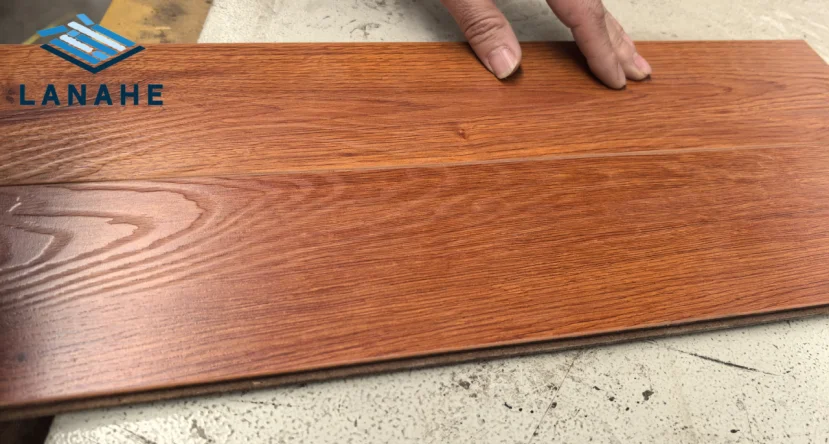
Preparing for Laminate Flooring Installation
Choosing the Right Laminate Flooring Brands
Picking good laminate flooring brands is super important. It helps make your floor strong and pretty. Look for brands that focus on quality, green materials, and cool designs. For example, Shandong Lanhe Import and Export Co., Ltd. has lots of laminate flooring options. They fit different tastes and needs. Their models, like 31801-14, 31804-13, and 31806-9, mix toughness with style. These floors handle wear well and still look great.
Lanhe Flooring makes sure their products are top-notch. They use high-tech machines and strict checks. Whether for homes or businesses, choosing a trusted brand like Lanhe means you get floors that work well and look nice.
Tools and Materials Needed for Installation
Before starting laminate flooring installation, gather your tools and stuff. This makes the job smooth. You’ll need:
A tape measure to measure exactly.
A utility knife or laminate cutter for clean cuts.
Spacers to keep gaps for expansion.
A rubber mallet to lock planks together.
Underlayment to add cushion and block water.
Glue (if your laminate needs it).
Also, wear safety gear like gloves and goggles. This keeps you safe while working.
Measuring and Preparing the Subfloor
Getting the subfloor ready is a big deal for laminate flooring installation. First, clean it well. Remove dust, dirt, or junk. Use a level to check if it’s flat. If you find high spots, sand them down. For low spots, use leveling compound to fill them.
Laminate flooring needs a steady base. This stops creaking or shifting later. Make sure the subfloor is dry. Wetness can hurt the laminate planks.

Steps to Install Laminate Flooring
How to Install Laminate Flooring: Step-by-Step Guide
Here’s how to install laminate flooring in easy steps:
Clear the Area: Move furniture and stuff out of the way.
Put Down Underlayment: Roll out underlayment over the subfloor. Cover every bit without overlapping.
Plan the Layout: Pick a starting spot. Lay planks without locking them to see how they fit.
Cut Planks: Use a utility knife or cutter to trim planks for edges or obstacles.
Lock Planks: Start with the first row. Connect each plank using their tongue-and-groove system.
Keep Gaps: Place spacers between planks and walls. This gives room for planks to expand with temperature changes.
Laying the Underlayment for Laminate Flooring
Underlayment is like a shield between your laminate flooring and the subfloor. It helps with sound, adds cushion, and stops water damage. Roll it out along your starting wall. Make sure rows don’t overlap. If needed, use tape to hold it in place.
Good underlayment makes your laminate flooring last longer. It also makes it work better.
Installing the First Row of Laminate Planks
The first row is the base for your whole laminate flooring installation:
Line up planks along your starting wall. Keep their tongues facing out.
Put spacers between planks and walls. This keeps even gaps for expansion.
Lock planks together. Use a rubber mallet to tap their grooves tight.
When the first row is done, move to the next rows. Stagger the seams for extra strength.
Common Challenges in Laminate Flooring Installation
Dealing with Uneven Subfloors
Uneven subfloors can mess up your laminate flooring installation:
Use a straight edge or level to find bumpy spots.
Sand down high areas. Fill low spots with leveling compound until it’s flat.
A smooth subfloor keeps your laminate flooring steady over time.
Cutting and Fitting Around Obstacles
Cutting planks to fit around doors, pipes, or other stuff needs care:
Measure obstacles exactly with a tape measure.
Mark cut lines on planks. Then, trim them with a jigsaw or utility knife.
Be extra careful with tricky shapes like corners or curves.
Tips for a Professional Finish
Ensuring Proper Spacing and Expansion Gaps
Getting spacing and expansion gaps right is key for laminate flooring. Planks grow and shrink with heat and humidity. Without enough gaps, floors can buckle or warp. Use spacers during laminate flooring installation to keep gaps between planks and walls. These spacers make sure there’s room for the floor to move without breaking.
Shandong Lanhe Import and Export Co., Ltd. suggests keeping a gap of 10-12mm around the room’s edges. This includes spots near doors, pipes, or other obstacles. It helps the floor stay stable through seasonal changes.
Also, don’t put heavy furniture right against walls without pads or protection. This can close gaps and cause damage. Follow these tips to get a pro-looking floor that lasts.
Cleaning and Sealing After Installation
After laminate flooring installation, clean it well. Remove dust or bits from the process. Use a soft broom or vacuum with a wood floor setting. Don’t use too much water or strong chemicals. These can harm the laminate’s top layer.
Most laminate flooring doesn’t need sealing. It already has a tough coating. But in wet areas like kitchens or bathrooms, some people add edge sealing for extra safety. Models like 31801-14, 31804-13, and 31806-9 from Lanhe Flooring are great against water. This means you usually don’t need extra sealing.
For regular cleaning, use a damp mop with a gentle cleaner made for laminates. This keeps your floors shiny and makes them last longer.
Maintaining Your Newly Installed Laminate Flooring
Regular Cleaning and Maintenance Tips
To keep your laminate flooring awesome, clean it regularly. Sweep or vacuum every day to get rid of dirt that could scratch it. For deeper cleaning, use a microfiber mop with water or a laminate-safe cleaner.
Don’t use rough tools like steel wool. They can hurt the floor’s top layer. Products from Shandong Lanhe Import and Export Co., Ltd. have strong coatings. These fight scratches and stains well.
For tough stains like grease or ink, use a tiny bit of nail polish remover on a cloth. Rub gently. Always test cleaners on a hidden spot first.
Avoiding Damage to Your Laminate Floors
Stopping damage keeps your laminate flooring pretty and strong. Here are some tips:
Use Furniture Pads: Put felt pads on furniture legs. This stops scratches when moving stuff.
Add Mats at Doors: Place doormats at entrances. They catch dirt and water before it hits the floor.
Control Humidity: Keep indoor humidity between 35-65%. Use a dehumidifier or humidifier if needed.
Don’t Drag Heavy Stuff: Lift big furniture instead of sliding it. This avoids deep scratches.
Block Sunlight: Too much sun can fade laminate patterns. Use curtains or blinds during bright hours.
These steps help your laminate flooring stay beautiful for years.
FAQ
How do I fix gaps between laminate planks?
Gaps can happen from bad installation or temperature changes. Use a pull bar tool to tap planks back together gently.
Can I install laminate flooring in bathrooms?
Yes, but use water-resistant models like 31806-9 from Lanhe Flooring. Seal edges well for extra water protection.
What type of underlayment should I use?
Pick underlayment based on your subfloor. Foam works great for concrete. Cork is better for sound on wood subfloors.
How do I prevent my laminate floors from creaking?
Make sure the subfloor is flat before laminate flooring installation. Uneven spots often cause creaking.
Why choose Shandong Lanhe’s products?
Lanhe Flooring mixes toughness with style using high-tech building. Their custom options fit many needs with great quality.
For more info about top-quality solutions from Shandong Lanhe Import & Export Co., Ltd., contact us today!


